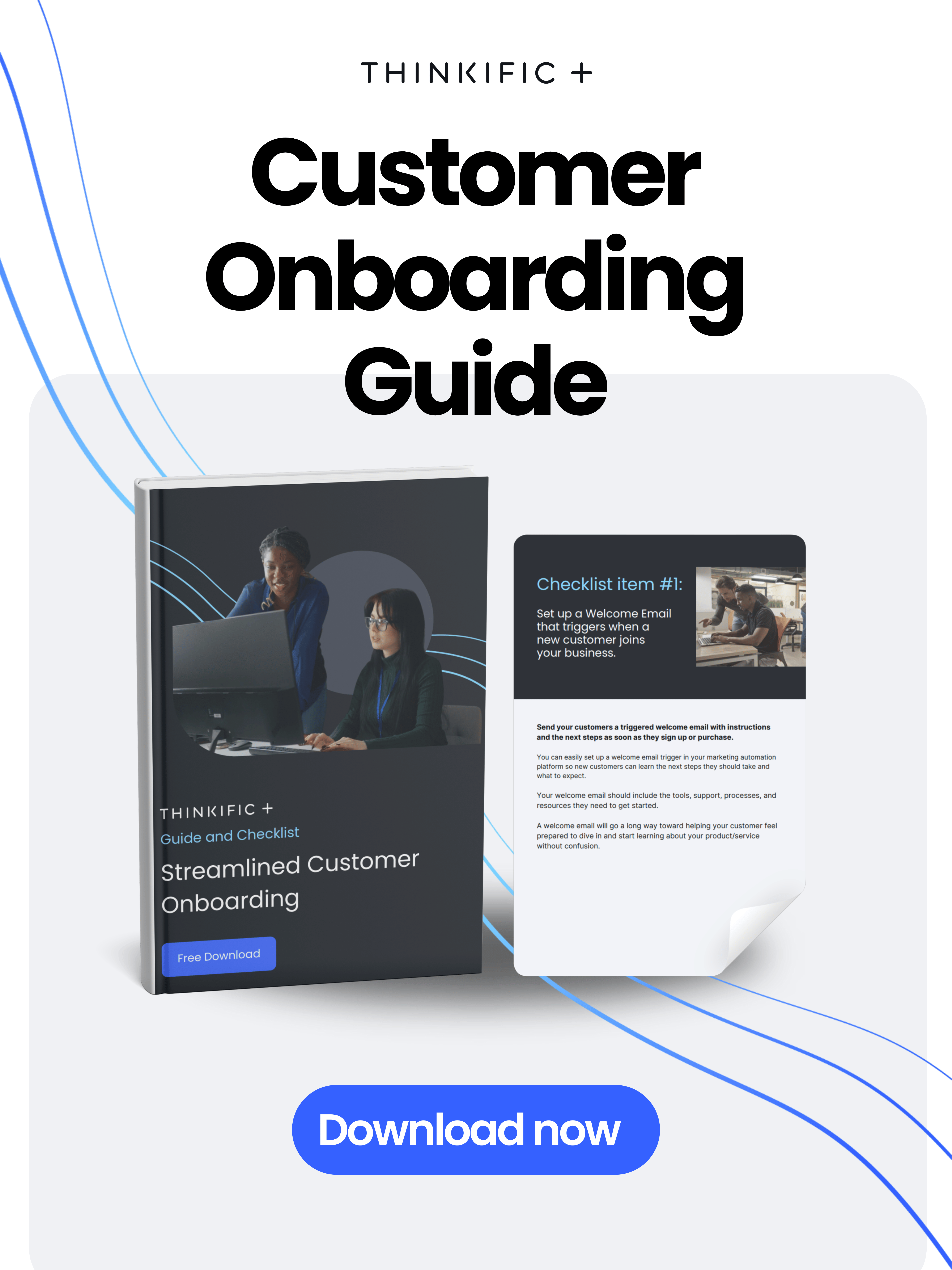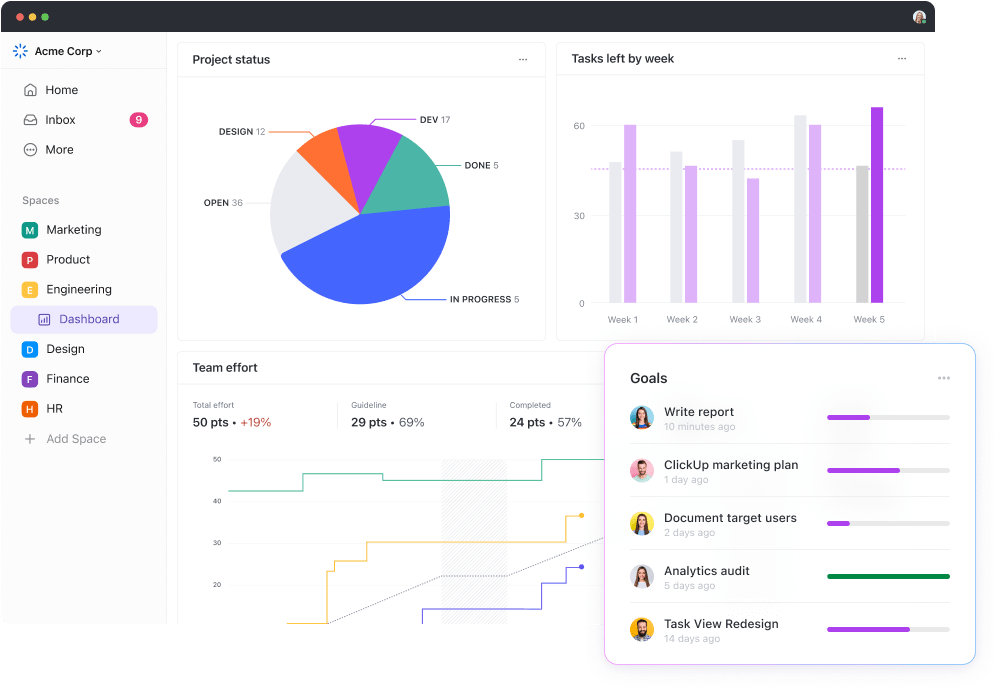Imagine this – a new customer signs up for your product, full of excitement and expectation. But a month later, they’ve disengaged, confused, and on the verge of canceling. Sound familiar? Poor onboarding is often the culprit behind high churn rates, while a seamless, value-driven onboarding experience can turn hesitant new users into loyal, long-term advocates. In fact, 86% of customers say they will remain loyal to a business if onboarding and ongoing education are provided.
Customer onboarding isn’t just a series of steps – it’s the foundation for growth and retention. It shapes how your customers perceive your product, dictates their speed to success, and plays a pivotal role in reducing churn (aka customer loss). In the fast-paced world of SaaS and B2B, onboarding sets the tone for the entire customer relationship.
A strategic onboarding process ensures that your customers see value quickly, feel supported, and become proficient with your product. This blog will cover everything you and your team need to know to create an onboarding experience that not only educates but inspires confidence, loyalty, and expansion.
Skip ahead:
Customer onboarding is the process of introducing new customers to your product or service, ensuring they understand how to use it effectively to achieve their goals. For B2B companies, particularly those in SaaS, customer onboarding is critical for driving product adoption, reducing churn, and building long-term customer loyalty.
At its core, onboarding focuses on delivering value quickly, aligning the customer’s needs with the product’s capabilities, and setting the foundation for ongoing engagement. A robust onboarding experience is particularly essential for businesses where high-value customer relationships and retention directly impacts revenue growth.
Companies can foster trust, streamline adoption, and establish a partnership mindset by guiding customers through setup, education, and early wins.
Customer onboarding is more than just a first impression – it’s the bridge that connects excitement to long-term success. A well-crafted onboarding experience ensures that new customers not only understand your product but feel supported, valued, and empowered to achieve their goals. This critical phase lays the groundwork for lasting relationships, reduces the potential for customer loss, and accelerates growth by driving early wins. Even the most promising customers can disengage without effective onboarding, leaving potential value untapped.
In this section, we’ll explore why onboarding plays a pivotal role in building trust, increasing retention, and turning customers into loyal advocates who drive expansion and growth within your organization.
Here’s why it’s essential:
- Building long-term relationships
Effective onboarding establishes trust and ensures that customers feel supported from the start. By addressing their unique needs and demonstrating a commitment to their success, you foster relationships that lead to loyalty and advocacy. - Preventing Churn
Customers who fail to see value quickly are more likely to leave. A well-structured onboarding program reduces churn by guiding users through early challenges and showing them how your product solves their pain points. - Expediting Time To Value (TTV)
Time to value is the period of time that it takes for customers to achieve their first meaningful outcome with your product. Onboarding accelerates this process by providing clear, actionable guidance, leading to higher satisfaction and retention rates. - Driving account expansion
When customers experience success during onboarding, they are more likely to explore additional features, upgrade their plans, or invest in complementary products, creating opportunities for account growth. - Creating champions for your products
A great onboarding experience empowers customers to become product advocates. These champions drive word-of-mouth referrals and enhance internal buy-in within their organizations, increasing your product’s visibility and usage.
By creating a strong foundation during the onboarding process, you and your team can ensure that your customers are set up for success from the start.
However, even the best-designed onboarding programs aren’t without challenges. Many businesses are turning to customer education to bridge the gap and sustain momentum—a scalable solution that keeps customers engaged, informed and continuously growing with your product.
Transitioning from onboarding to broader customer education is key to maintaining engagement and driving sustained success.
For companies investing in customer education, the goal is to equip users with the knowledge they need to succeed—through onboarding programs, training courses, webinars, and self-serve resources. This education helps drive product adoption, reduce churn, and create long-term advocates.
However, even the most well-intentioned customer education initiatives can face obstacles that hinder their effectiveness. From low engagement with materials to poor adoption of advanced features, these hurdles can slow growth and limit the return on your educational efforts.
Here’s how to address the most common challenges:
- Low engagement
Despite offering educational content, customers may not consistently interact with materials if they feel irrelevant, overly complex, or time-consuming. Companies often struggle to capture attention in a crowded digital space. To overcome this, personalize the learning experience with targeted content, use multimedia formats, and employ engagement tactics like gamification or quizzes to keep users interested. - Poor adoption rates
Even after delivering onboarding and training, some customers may not adopt the full range of product features, limiting their overall success. This often happens when educational content is too generic or doesn’t align with specific use cases. Combat this by creating advanced tutorials, hosting live training sessions, and offering on-demand resources tailored to user roles or industries. - Churn during onboarding
Customers frequently churn during the onboarding phase when they feel unsupported or overwhelmed. Despite offering guides and documentation, companies may find that users drop off without completing setup or achieving early wins. Simplify onboarding by breaking it into manageable steps or learning paths, providing real-time support, and setting up automated touchpoints to guide them through initial hurdles.
These challenges highlight the importance of aligning customer education with real user needs and preferences. When addressed strategically, education can become a powerful tool for driving retention, adoption, and long-term customer loyalty.
A seamless and effective customer onboarding process is the key to setting your customers up for long-term success. Let’s break down the essential steps to create an onboarding experience that builds trust, reduces churn, and accelerates product adoption for your business.
-
Welcome and onboarding emails
The first touchpoint sets the tone for your relationship. Send a series of personalized welcome emails that:
- Introduce your team and provide a human touch.
- Share quick-start resources like getting started guides, an online academy, or FAQs.
- Set expectations for the onboarding process, including key milestones.
Pro tip: Use automated workflows to ensure every customer receives timely, relevant communication tailored to their role or industry.

Example: SaaS Company Outgrow’s onboarding email
- Product walkthroughs, online courses, and demos
Customers need hands-on experience to feel confident with your product. Provide interactive ways for them to learn:- Online courses: Offer structured, self-paced learning modules tailored to different user needs. Thinkific Plus makes this easy by letting you and your team build dynamic courses with videos, quizzes, and downloadable resources.
- Guided walkthroughs: Automate in-app tutorials that guide users through the core features, ensuring they feel comfortable navigating your product.
- Live demos: Host virtual or in-person demos to provide real-time support, address questions, and demonstrate value.
These tools empower users and allow them to learn at their own pace, reducing the pressure and increasing retention.
P.S: Make onboarding easier with our Customer Onboarding Templates and Checklist below:

- Personalization and setup assistance
Tailoring the onboarding process to the unique needs of each customer ensures a more engaging experience. Steps include:- Needs assessment: Identify specific goals during the onboarding phase to customize training and resources.
- Custom setup: Provide one-on-one setup assistance to ensure the customer’s environment matches their business objectives.
- Role-specific content: Deliver tailored materials for different roles within the organization, from admins to end-users.
Personalization fosters stronger relationships and ensures that customers feel supported from the start.
- Continued support and engagement
Onboarding doesn’t end after the first 30 days. Keep the momentum going by:
- Providing ongoing resources, such as webinars, advanced courses, and case studies.
- Sending periodic check-ins to gather feedback and identify gaps.
- Leveraging LMS analytics to track customer progress and refine your approach.
By embedding customer education into your onboarding process and overall customer experience, you create a scalable, effective system that boosts adoption, drives loyalty, and transforms your customers into long-term advocates.
When designing an effective customer onboarding strategy for your business, it’s key to focus on simplicity, scalability, and personalization to deliver exceptional results.
Here are some key best practices to consider:
- Keep the process simple and intuitive
A straightforward onboarding process ensures customers aren’t overwhelmed. Use clear instructions, concise materials, and streamlined workflows to ensure a smooth start. - Streamline and standardize onboarding with an online course
Create a structured, scalable onboarding experience by offering self-paced online courses. Platforms like Thinkific Plus make it easy to build engaging courses tailored to different user needs, reducing the demand for one-on-one training. - Provide ongoing education and training resources
Extend the value of onboarding by offering continuous learning opportunities, such as advanced tutorials, webinars, and certifications, to help customers deepen their understanding over time. - Personalize the onboarding experience for each customer
Customize your approach based on the customer’s role, goals, and business challenges. Personalization builds trust and ensures each user feels supported. - Regularly collect feedback to improve the process
Use surveys, interviews, and analytics to gather customer insights. Continuously iterate on your onboarding strategy to address pain points and improve the user experience. - Set clear expectations from day one
Communicate the onboarding timeline, key milestones, and success metrics. This transparency fosters alignment and keeps customers motivated. - Leverage engagement tools
Incorporate interactive elements like quizzes, surveys, and gamified features to make onboarding more engaging and reinforce learning.
When done right, onboarding becomes more than just a necessary step — it evolves into a driver of customer empowerment, setting the stage for deeper product usage and long-term satisfaction.
To ensure your customer onboarding program delivers measurable results, it’s critical to monitor and analyze key performance indicators (KPIs).
Here are the most important metrics to track:
- Customer retention rate
Retention rate measures the percentage of customers who stay with your company over a specific time period. A strong retention rate indicates successful onboarding, as customers who feel supported and see value are less likely to churn. - Time-to-value (TTV)
TTV tracks how quickly customers achieve their first major success or “aha moment” with your product. The faster customers see value, the more likely they are to stay engaged and become long-term users. - Product adoption rate
This metric shows the percentage of customers actively using your product’s key features. High adoption rates indicate that your onboarding process effectively teaches customers how to leverage the product to meet their goals.
Looking to learn more about key customer education benchmarks to track and measure your program’s success?
Dive deeper in our latest Customer Education Benchmarks and ROI Report.

LMS metrics and KPIs for customer education courses
If your onboarding includes an online course, it’s best practice to track LMS-specific metrics such as course completion rates, average time spent on courses, assessment scores, and quiz engagement.
These data points highlight how well customers engage with your educational content and where improvements might be needed.
- User Engagement
Engagement measures how actively customers interact with your onboarding materials, such as tutorials, emails, and webinars. Low engagement could indicate that the content isn’t resonating or needs to be presented differently. - Feature activation rate
Track how many customers activate specific features during onboarding. This indicates whether they’re exploring and using the functionalities they need to succeed. - Net promoter score (NPS)
NPS measures customer satisfaction by asking how likely they are to recommend your product to others. An improved NPS after onboarding suggests that customers have had a positive initial experience. - Churn during onboarding
Monitor the rate at which customers cancel during or immediately after onboarding. A high churn rate could point to issues in the onboarding process that need to be addressed.
By regularly analyzing these metrics, you and your team can refine your onboarding strategy, address challenges early, and ensure a seamless and successful onboarding experience for every customer.
Creating a comprehensive and effective customer onboarding strategy involves a step-by-step approach to ensure your customers feel supported every step of the way, truly understand your product, and have the knowledge to achieve their goals.
Use this checklist to guide your process:
Step 1: Define your onboarding goals
Spend some time with your team to clearly outline what you want your onboarding program to achieve. For example:
-
- Reduce time-to-value (TTV) for customers.
- Improve feature adoption rates.
- Decrease churn during onboarding.
- Build stronger long-term customer relationships.
Align these goals with your overall business objectives to ensure onboarding contributes to company-wide success.
Step 2: Map the customer journey
- Document the customer journey from initial sign-up to long-term success.
- Identify key touchpoints where onboarding materials and support will be most impactful.
- Consider different personas to tailor onboarding for specific customer needs and use cases.

Step 3: Audit existing resources
- Collect and review current training materials, emails, product walkthroughs, and support documentation.
- Identify gaps in your resources that need to be filled to support a seamless onboarding process.
Step 4: Create an onboarding framework
- Outline the key phases of your onboarding process:
- Welcome phase: Introduce customers to your team and set expectations.
- Initial setup: Provide personalized support to help customers configure their accounts.
- Education phase: Use online courses, guided walkthroughs, and videos to teach customers how to use key features.
- Check-ins and feedback loops: Ensure customers are on track and collect feedback to improve your process.
Step 5: Leverage automation tools
- Use tools like an LMS to automate training and deliver a consistent experience.
- Automate welcome emails, milestone notifications, and reminders.
- Incorporate a knowledge base or self-paced onboarding courses to allow customers to explore at their own speed.
Step 6: Personalize the experience
- Segment customers by industry, company size, or specific use case to deliver tailored onboarding materials.
- Offer custom learning paths based on a customer’s goals and prior knowledge.
- Use check-ins and surveys to adapt the process as needed.
Step 7: Incorporate customer education
- Create educational resources such as webinars, FAQs, and tutorials to empower customers.
- Offer additional learning opportunities after onboarding to support mid-term and long-term retention.
Step 8: Track key metrics
- Monitor the metrics outlined in the earlier section, such as TTV, feature adoption rate, and churn rate.
- Use insights to refine your onboarding process and identify areas of improvement.
Step 9: Gather feedback and iterate
- Collect feedback from customers via surveys and informal conversations.
- Use analytics from your LMS or CRM to identify pain points in the onboarding process.
- Regularly update onboarding materials to align with product updates and customer needs.
Step 10: Scale and optimize
- As your customer base grows, ensure your onboarding process can scale efficiently.
- Invest in tools like Thinkific Plus to automate and standardize onboarding across different customer segments.
- Continuously test and refine to keep the process fresh, relevant, and impactful.
Effective customer onboarding is crucial for ensuring users understand and derive value from your product. Here are three companies that excel in different stages of the onboarding process:
1. Slack: Seamless initial setup
Slack simplifies the initial setup with a user-friendly interface and guided prompts. Upon signing up, users are led through creating a workspace, inviting team members, and integrating essential tools. This streamlined process ensures that new users can start collaborating immediately without confusion.

Image: Slack’s interactive tour
2. Asana: Interactive product tours
Asana offers interactive product tours that highlight key features and functionalities. New users are presented with a guided walkthrough that demonstrates how to create tasks, set deadlines, and manage projects effectively. This hands-on approach helps users quickly grasp the platform’s capabilities.

Image: Asana’s onboarding checklist
3. Dropbox: Ongoing user education
Dropbox provides continuous user education through a comprehensive help center and regular webinars. Users have access to a wealth of resources that cover basic to advanced functionalities, ensuring they can maximize the platform’s potential over time.

Image: Dropbox’s guided product tour
By analyzing and drawing inspiration from these examples, you can enhance your own onboarding process to better serve your customers.
Customer education is the backbone of a successful onboarding process, bridging the gap between initial engagement and long-term value. By empowering customers with the knowledge and skills they need to succeed, education reduces friction, accelerates product adoption, and fosters lasting relationships.
For many businesses, the challenge lies in delivering education that is accessible, engaging, and scalable. This is where a customer education platform like Thinkific Plus excels.
By transforming traditional onboarding resources—like walkthroughs, live trainings, and static documentation—into dynamic, interactive online courses, businesses can create a streamlined, self-paced experience that meets customers where they are.
Customer education doesn’t stop after the first 30 days. It lays the groundwork for continuous learning, helping customers unlock new features, deepen their understanding of the product, and discover additional use cases. Scalable platforms allow businesses to deliver this education at every stage of the customer lifecycle while capturing valuable data on engagement, progress, and outcomes.
How Thinkific Plus supports scalable onboarding
- Customizable learning paths: Tailor onboarding courses to fit customer personas or use cases, ensuring relevance and effectiveness.
- Engagement features: Use tools like quizzes, certificates, and feedback forms to enhance retention and make learning enjoyable.
- Actionable insights: Access LMS analytics to measure onboarding success and optimize course content based on user performance.
- Automation: Save time and resources by automating the delivery of onboarding materials while maintaining a personal touch.
Customer education isn’t just a support tool—it’s a strategic lever for improving onboarding and scaling customer success. By leveraging a robust LMS, you and your team can reduce churn, boost retention, and turn customers into champions of your brand.
Conclusion
A strong customer onboarding process is more than a welcome—it’s the foundation for lasting relationships, reduced churn, and accelerated growth. From creating seamless first interactions to providing ongoing education and support, a thoughtful onboarding strategy ensures your customers see value quickly and stay engaged over time.
Customer education is critical in scaling this experience, equipping your team with the tools to deliver personalized, impactful, and efficient onboarding at every stage. By leveraging platforms like Thinkific Plus, you can streamline the process, boost adoption rates, and set the stage for long-term success.
Ready to transform your customer onboarding?
Download our free Customer Onboarding Guide today to learn how to design an onboarding strategy that delivers measurable results.

Customer onboarding FAQs
- What’s the onboarding process for a new customer?
The customer onboarding process involves guiding new customers through the steps needed to start using your product or service effectively. This typically includes sending welcome emails, providing product walkthroughs or demos, offering setup assistance, and delivering ongoing education to ensure long-term success. - What is an example of customer onboarding?
A SaaS company might onboard new users by sending a welcome email series, offering an online course to teach key product features, and hosting live Q&A webinars. For example, Hootsuite Academy uses an LMS to deliver engaging training modules that help customers maximize their use of the platform while building confidence and expertise. - Why is customer onboarding so important?
Customer onboarding sets the tone for your relationship with new customers. A strong onboarding process ensures they quickly see value in your product, which drives retention, boosts adoption rates, and reduces churn. It also builds trust and equips customers to succeed, turning them into long-term advocates for your brand.



/cdn.vox-cdn.com/uploads/chorus_asset/file/25839687/2194358215.jpg)






